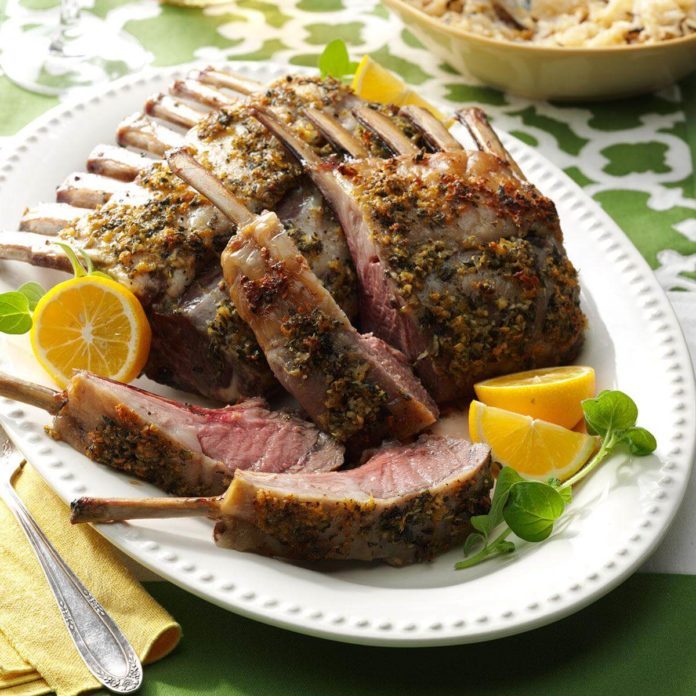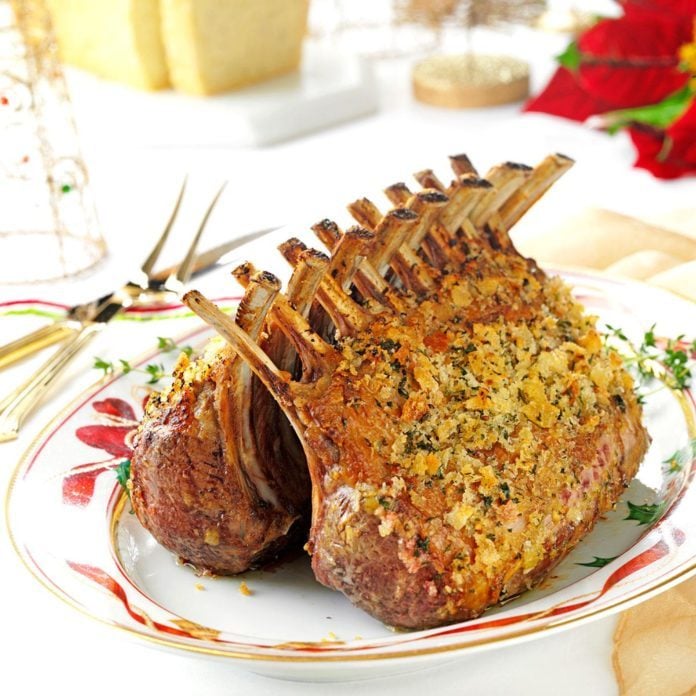Here’s the thing about lamb: it’s amazing. Almost every cut of lamb is naturally tender, and you don’t need to add much seasoning to make it full-flavored. It’s fancy enough to serve for a dinner party or holiday meal, but it’s also simple and easy enough to cook for a weeknight dinner. As a bonus, it’s also a healthy, lean source of protein that’s chock-full of vitamin B12, vitamin B6 and niacin, as well as zinc, selenium and iron to boost immune support.
Outside of America, this tender meat is wildly popular, but somehow it’s missing from our dinner tables. So, what’s the problem? Some people find the gamey flavor of lamb to be distasteful. The good news is you can absolutely control the flavor of lamb by choosing the right cuts and cooking it properly. Follow along with our in-depth lamb cooking guide that will help you get there.
What Does Lamb Taste Like?
Most lamb is grass-finished, which gives lamb its unique flavor. Some people describe the flavor as “gamey,” but we prefer using words like grassy, well-balanced, robust or pastoral. The flavor comes from branched-chain fatty acids (BCFAs) in the lamb’s fat. Some breeds naturally contain more BCFAs than others, but the concentration of these compounds is largely influenced by diet. Lamb from New Zealand and Australia graze on grass their entire lives and contain more BCFAs in their fat. American lamb is often grain-finished, which reduces the concentration of BCFAs, giving the lamb a richer, sweeter flavor.
What Are the Best Cuts of Lamb?
Some cuts of lamb have more gamey flavor than others because of their overall fat content. If that flavor isn’t to your liking, avoid cuts from the shoulder, shank and leg. This includes shoulder chops, bone-in or boneless leg of lamb, and stew meat. Instead, look to leaner cuts like rib chops, loin chops and rack of lamb, which have less fat and taste sweeter.
That said, leg of lamb is one of my favorite cuts. Although it has a more intense pastoral flavor as compared to the rack, it’s significantly less expensive and super easy to cook. If you find the flavor offensive, try buying a butterflied leg of lamb. You can trim off and remove the fat from the inside of the leg, reducing the funky flavor. Try this top-rated roast leg of lamb recipe.
Where to Buy Lamb
Most grocery stores sell lamb chops, lamb steaks, stew meat and ground lamb (perfect for lamb burgers). Some stores even sell rack of lamb, which is my go-to choice for a super-fancy meal. Leg of lamb is equally impressive, and it’s great for feeding a crowd. It might be more difficult to find where to buy leg of lamb, especially a bone-in leg. Many butcher shops carry them, and you can almost always special order one if you ask.
How to Buy a Leg of Lamb
Leg of lamb comes in three different packages: bone-in, boneless and butterflied. Bone-in leg of lamb might contain the shank (French style) or the shank bone may be removed (American style). Either way, keep in mind that while bone-in leg of lamb is usually less expensive than boneless, you’re also paying for the weight of the bone.
The bone has been removed for boneless leg of lamb cuts, creating an uneven piece of meat. That means it needs to be rolled and tied for even cooking. Most boneless leg of lamb comes in netting, which means it’s already rolled up and tied. It’s convenient, but you would have to cut the netting open to season the inside of the roast. Butterflied leg of lamb, on the other hand, is also boneless but it’s not tied. This makes seasoning easier, but you have to know how to roll and truss the roast before cooking it. (Don’t worry: It’s just as easy as tying a pot roast).
How Much Is a Leg of Lamb?
Prices on lamb vary greatly between the different cuts and where the lamb was raised. An American-raised, boneless leg of lamb might cost $10 to $13 per pound, whereas a rack of lamb can run from $16 to $20 per pound. The prices of New Zealand and Australia lamb are almost always less expensive. Even though they have to be shipped internationally, these countries raise significantly more lamb than we do in America, driving down the cost.
How Much Lamb Should I Serve Per Person?
A leg of lamb is a great way to feed a crowd. It’s best to estimate about 8 ounces of uncooked boneless lamb per person, or 12 ounces of uncooked bone-in lamb per person. When it comes to rack of lamb, most racks contain seven or eight ribs. You can estimate each person will consume two ribs for American lamb, or three to four ribs for Australian lamb because it’s smaller.
How to Season Leg of Lamb
Because leg of lamb is naturally tender, it doesn’t need to be marinated. In fact, acidic marinades can break down the fibers of the lamb and cause it to become tough. Instead, we’ve found it best to season lamb simply with salt and pepper, along with other aromatic ingredients like chopped garlic, rosemary and oregano. Let it rest for 30 minutes to three hours before cooking.
Want even more flavor? Add a fruity and flavorful glaze to your leg of lamb, like the one we use in this Plum-Glazed Lamb recipe, for a special touch.

Leg of Lamb Cooking Time
As a general rule of thumb, leg of lamb takes 20 to 30 minutes per pound in a 350° oven, depending on the desired level of doneness. A bone-in leg usually cooks more quickly than a boneless leg, but you can count on anywhere from 1-1/2 to 2-1/2 hours for the leg of lamb to reach medium-rare. That said, we definitely recommend using an instant-read thermometer to know for sure when the lamb is finished cooking.
Leg of Lamb Temperature
Lamb is best served medium-rare. Rare is a little too tough for our liking, and well-done is dry and chewy. In general, lamb temperatures are the same as beef temperatures. You’ll also want to rest lamb for at least 15 minutes before slicing to let the juices redistribute within the meat.
- Rare (cold, red center): 120 to 125°.
- Medium-rare (warm, red center): 130 to 135°.
- Medium (warm, pink center): 140 to 145°.
- Medium-well (hot, slightly pink center): 150 to 155°.
- Well-done (brown all the way through): 160 to 165°.
Looking for the best way to tell if meat is finished cooking? Invest in an instant-read thermometer ($100) for the most accurate results.
How to Carve a Leg of Lamb
Boneless leg of lamb is so much easier to carve because you don’t have to worry about hitting a bone.
To carve boneless lamb:
- After the lamb rests, simply remove the netting and place the lamb on a cutting board.
- Cut the lamb against the grain with a sharp knife to create even slices.
To carve bone-in lamb:
- Position the lamb on the cutting board with the bone facing towards you.
- Starting on the outside edge, cut a few slices from the lamb until the leg sits flat when it rests on the cut side.
- Then, turn the lamb so the bone is perpendicular to your knife. Starting at one end, cut the leg against the grain, making 1/4- to 1/2-inch slices perpendicular to the bone until you’ve sliced through the entire leg. Cut all the way down to the bone, but keep in mind that most of the slices will still be attached to the bone at this point.
- When you reach the end, turn your knife parallel to the bone and make a long slice along the top of the bone to free the perpendicular slices.
- Turn the leg over and do the exact same thing to the other side.
If there is any meat left on the bone, you can remove it for leftover sandwiches. It won’t be as pretty as the slices, but it’s still delicious!
Put your newfound knowledge to the test with our top lamb recipes.
The post Your Guide to Buying and Cooking Lamb appeared first on Taste of Home.
Lindsay D. Mattison

























